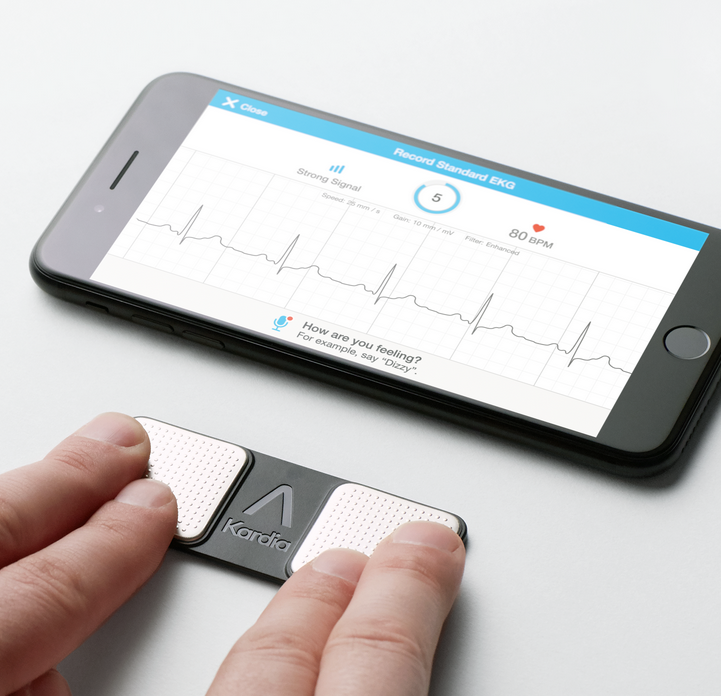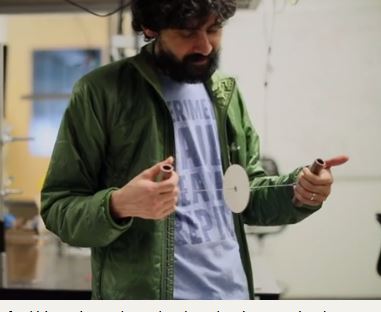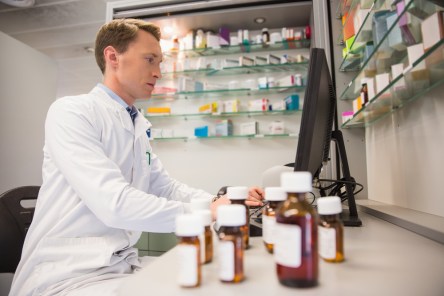Ruthless and unbiased, heart disease kills 610,000 people per year in the United States, amounting to one out of every four deaths in the country. A leading cause of death across both genders, the CDC estimates that over half of the nation’s deaths can be attributed to heart disease. Doctors say early detection is key, by the time significant warning signs like chest pain and shortness of breath are detectable, it might already be too late. Unfortunately, for many Americans, a trip to the doctor’s office can be complicated and costly. But what if an EKG could fit inside your wallet? A new mobile EKG device can monitor cardiac health and track the early warning signs of hearth disease and stroke. Mobile Monitoring AliveCor, the makers behind Kardia, a mobile, pocket-sized EKG monitor, believe they’ve found a solution. A little smaller than a business card, the Kardia comes outfitted with two metal plates designed to receive basic information about the user’s heart, including heart rate, blood pressure and – most importantly – atrial fibrillation. Users simply place their fingers on the device and wait for the data to be transmitted to Kardia’s mobile app. The focus on atrial fibrillation is significant because changes in this particular data set are often an early warning signs of stroke. Most hospital-grade EKGs measure 12 different aspects of the heartbeat, but focusing on atrial fibrillation, AliveCor was able to shrink their mobile electrocardiogram down to a gadget that easily fits in the palm of your hand. “[It is] the most common arrhythmia, the one that we need to detect, doesn’t need all 12 EKG leads,” AliveCor CEO Vic Gundotra tells Wired. “And it’s not invasive at all, it’s just like brushing your teeth every day.” Comprehensive Reports The Kardia...
Low-Tech Diagnostics
Frugal Science
For caregivers in economically depressed communities, even the simplest tests can be too expensive. But thanks to the Paperfuge, spinning biological samples for testing just got a whole lot more economical. The Paperfuge allows health care workers to perform important diagnostic tests in just a few minutes, all for less than a twenty-five cents. Understanding the need to provide low-cost, and low-tech, testing and diagnosis options to the developing world, Stanford Bioengineer Manu Prakash alighted on the idea of modifying a children’s toy into a cheap, functional centrifuge. It’s all a part of Prakash’s commitment to improving healthcare across the globe by pursuing the art of Frugal Science. “To me, Frugal Science is really designing with constraints in mind,” says Prakash in a video about the Paperfuge. “When we say ‘bringing tools the masses,’ we truly do mean the billions of people on the planet.” Low Energy, High Results Traditional centrifuges are bulky, expensive and require a robust energy supply, making them almost impossible to operate in far-flung reaches of the world. A StatSpin MP centrifuge, for example, can cost thousands of dollars and runs on electricity. For many economically challenged communities, standard medical equipment is too costly and resource intensive. Prakash and his team took on the challenge of making a more accessible – and affordable – version of this valuable diagnostic tool. “We told ourselves, we can design one, but it cannot require any electricity, and it needs to be light and portable – I need to be able to carry it in my pocket – and it needs to cost less than a dollar in parts.,” explains Prakash in the video. “By boxing ourselves in with constraints, we were able to think outside the box.” The Paperfuge fits all of those...
Electronic Only
New NY Prescription Law
With the click of a mouse, doctors in New York State will soon be able to abandon their sometimes illegible medication notes for electronic prescriptions. As of March 27, New York is the first state in the nation to require all physicians to use electronic prescriptions, a law backed up by fines and criminal penalties. The basis of the new mandate lies in a 2012 state law, I-Stop, designed to decrease prescription opioid abuse. I-Stop created an online registry listing all medications prescribed to an individual patient. In an effort to reduce substance abuse, doctors were required to check the list before prescribing any new medications. Far from infallible, I-Stop’s registry remained vulnerable to human error – intentional or unintentional – as even a minor misspelling could thwart medication tracking. The hope is that by shifting to an entirely electronic prescription system, medications can be carefully tracked and fraud mitigated, if not eliminated altogether. The prescriptions will be managed via the Surescripts network. Surescripts, which processes over 1 billion e-prescriptions per year, connects doctor’s offices, hospitals, pharmacists and health plans through an integrated platform. While the shift to electronic prescripts robs consumers of some agency –patients will have limited ability to change pharmacies – a 2015 survey by Surescripts revealed a majority of patients felt more secure with physicians who were “digitally connected.” In fact, more than 50% of survey respondents admitted online access to test results, medical records, and appointment scheduling would all be compelling enough to choose one doctor over another. Despite the law, many of New York’s health care providers have yet to make the switch to electronic prescriptions. As of January, a little over half of the state’s prescribers were able prescribe and send prescriptions electronically. Some of the state’s...
Yardi EHR
Senior Care Solutions
If you’ve been to the doctor lately, technology’s advance into the patient care and treatment realm was likely evident – whether your physician made notes on an iPad or your follow-up questions were addressed in an e-mail, medicine and mobile record-keeping have become inseparable. A similar transition has been underway in the realm of senior living, specifically in assisted-care communities. Yardi recently introduced Yardi EHR, an Electronic Health Record platform. Yardi EHR is the final piece in a single stack solution for assisted living and retirement communities, and provides seamless connectivity for resident care, medical record keeping, community marketing, property management, back office accounting, finance, and business intelligence. For companies looking for an enterprise solution to optimize their performance in the senior care sector, it is the perfect fit. “It really is just one completely integrated ERP and EHR solution, fully interoperable, and combining the knowledge of multiple teams from across all facets of the real estate, senior living, and healthcare industries,” said Fil Southerland, Director, Yardi Health Care Solutions. Southerland was an innovator of Yardi’s eMAR product, an Electronic Medication Administration Record that is now a module within Yardi EHR, and has extensive experience with senior living technology. We spoke with Southerland about the Yardi EHR product and its many advantages for senior living providers, pharmacies and investors. Read on for more insight. How have EHRs and the records that help run a senior living community typically interacted? Southerland: Linking care tracking with a financial/GL accounting system has, until now, never been seamless. Stand-alone EHR developers have bolted on bare bones accounting packages that aren’t fit to run care and housing organizations regional or national in scope. At Yardi, we’ve created an outstanding electronic health record, compliant with all HIPAA regulations. Who will...




